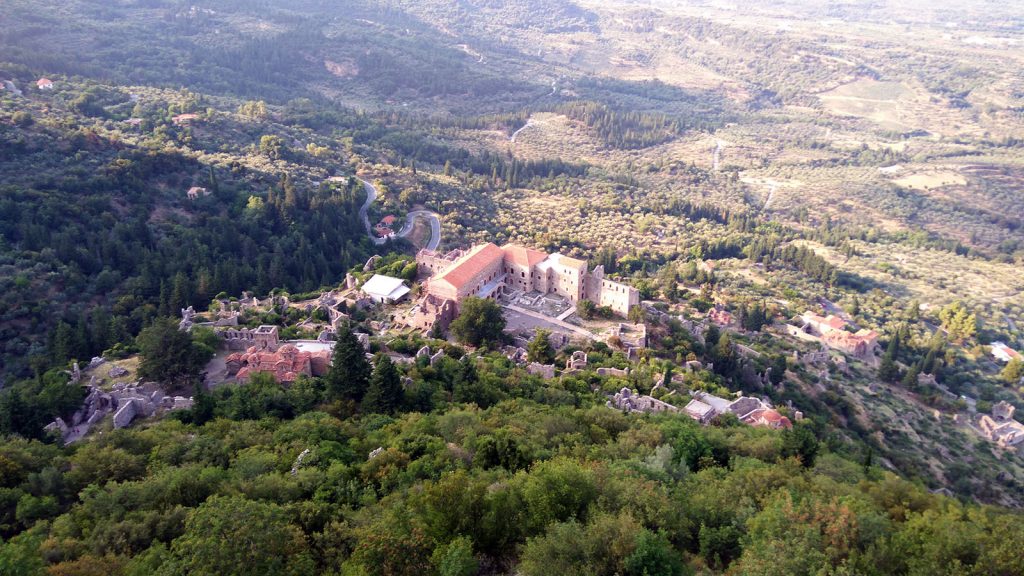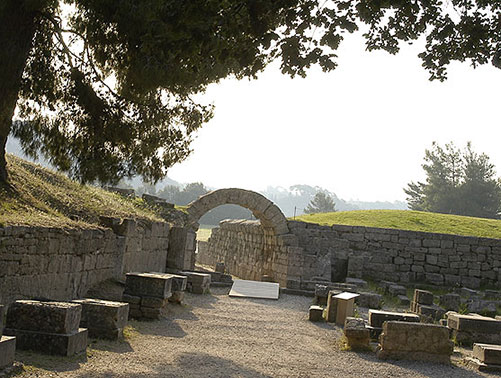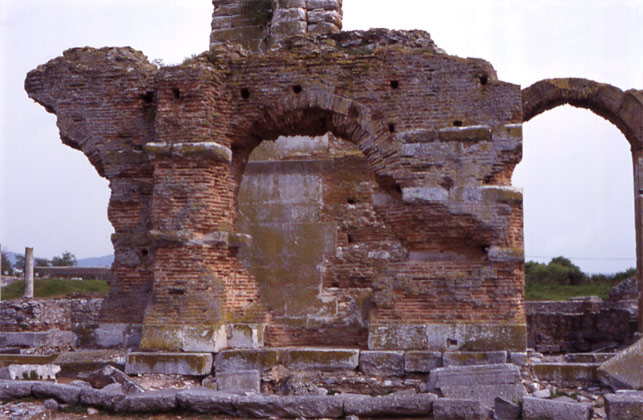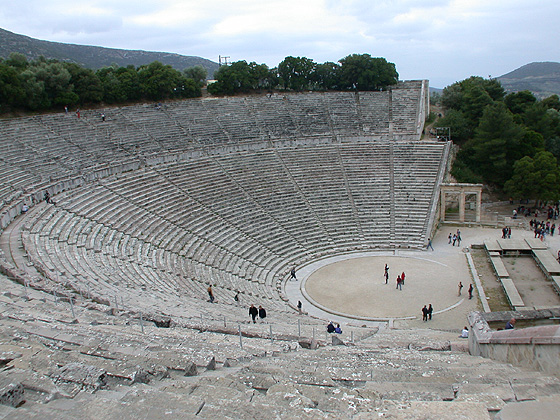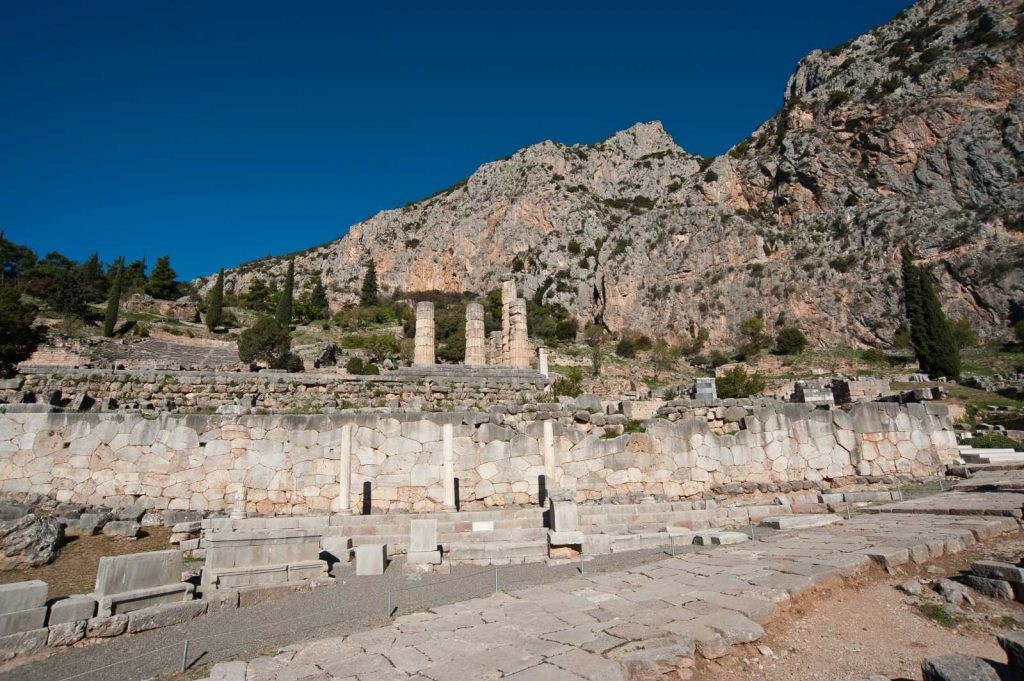The archeological site of Delphi was a sanctuary of Apollo and the most important oracle of the ancient Greek world. According to ancient tradition, the god himself descended to earth in search of a place to establish the first oracle, and after wandering in central Greece he ended up in Delphi. The site, however, was occupied by other deities, such as Gaia and Poseidon, and was guarded by a snake, Python. Apollo killed the snake and became the ruler of the site. The myth probably reflects the replacement of older religious notions related to the worship of deities associated with the earth by the worship of the Olympian gods.
In terms of nomenclature, the place was originally named Pythos (this is what Homer calls it). The word means “to cause decay”, in the tradition of decomposing the defeated snake (The Online Liddell-Scott-Jones Greek-English Lexicon, Πῡθώ). Once Apollo became a dominant deity, he was named Pythian, his priestess Pythia, and his feasts were called the Pythia. The name Delphi derives from the word δελφύς, meaning cavity (The Online Liddell-Scott-Jones Greek-English Lexicon, Delphi), and probably indicates that there was an ancient cult of Gaia in the area.
The aforementioned names are in line with the Delphic tradition, according to which the trigger for the founding of the oracle was a natural chasm in the area that gave off gas, which Pythia, during the delivery of the oracle, inhaled, fell into a state of ecstasy, and uttered inarticulate cries. Recent geological excavations in the rocky areas below the temple of Apollo, discovered traces of mild hallucinogenic gases, which reached and merged at this point with the waters of the springs of the area. Thus, the references to the method of divination seem to be scientifically substantiated.
Delphi developed amphitheatrically on a steep slope, at an altitude of 530-600 meters above sea level, overlooking the valley of Itea (the ancient Krissaion plain), the Gulf of Corinth, and the mountains of the northern Peloponnese. The sanctuary as well as the city of Delphi, were built on very high and steep cliffs known as Phaedriades. The main sanctuary was located approximately in the middle of the site and was surrounded by a precinct.
The sanctuary contained about 30 monuments built during the Archaic, Classical, and Hellenistic periods. In the middle of the sanctuary was the temple of Apollo, and around it were scattered the treasuries (small temple-shaped buildings of the Greek city-states that housed their dedications to the sanctuary), stoas, and other votive offerings. In the Hellenistic period, the theater was built north of the temple of Apollo, and on either side of the temple the portico of the Aetolians and the portico of Attalus. During the same period, the stadium was built northwest and outside the sanctuary, which in the 2nd century AD was renovated with a donation from the Athenian Herodes Atticus. To the south, below the modern road that crosses the area, was the sanctuary of Athena Pronaia, the tholos (a special circular building built in the 4th century BC), and the gymnasium.
In the Mycenaean period, Delphi was a village which was already inhabited since the end of the 16th century. Around 800 BC, the first elements for the worship of Apollo emerged, while in the 8th century it is certain that the sanctuary and the oracle were established within the settlement. Judging by the Homeric epics, which date to the second half of the 8th century, the oracle was already famous by then. Moreover, divination was still practiced in those early days.
The Archaic period (7th-6th century BC) was the time of the earliest flourishing of Delphi. In the 7th century, the site was connected with the amphictyony (union) of the city-states of Thessaly and central Greece, which were developing at that time. At one point, the members of the amphictyony moved their autumn sessions to Delphi, which gradually became its religious and political center. Thus, in addition to its religious splendor, Delphi became a pan-Hellenic political center. During this period the first important stone monuments were built in the sanctuary (e.g., the first temples of Apollo, the treasury of the Siphnians, the sphinx of the Naxians), while at the beginning of the 6th century the amphictyony established the Pythian games, a pan-Hellenic festival in honor of Apollo that would take place every four years, and which would include musical, athletic, and equestrian competitions.
The Classical period (5th-4th century BC) was the golden age of Delphi. After the end of the Persian Wars, the Greek city-states adorned the sanctuary with splendid buildings and votive offerings, some of which are landmarks of the Classical era (e.g., the gilded tripod-offering of the Greeks from the tenth of the spoils of the battle of Plataea in 479 BC, or the charioteer of Delphi). Athens played a leading role in this “frenzy” of votive offerings, which built its treasury and stoa in prominent parts of the sacred road (the main road leading to the temple of Apollo), which demonstrates the strong position it acquired after the Persian Wars.
During the Hellenistic and Roman times (3rd century BC – 3rd century AD) Delphi lost the political prestige it had acquired in the previous period (as a pan-Hellenic religious and informal political center). Political decisions affecting events in central and southern Greece were thereafter taken outside the region, in places where Delphi possessed little influence. The sanctuary was used by the new political forces as a place to declare their supremacy. In 168 BC, Aemilius Paullus, the victor in the battle of Pydna against the last king of Macedonia, Perseus, placed his equestrian statue on a high pedestal in front of the temple of Apollo. In 86 BC, the Roman general Sulla, as a result of the financial losses he had incurred during his war against the king of Pontus Mithridates, extracted many valuable votive offerings from Delphi. In 67 AD, Nero took part in the Pythian games, then distributed the plain of Krissa to his soldiers, and during his departure took with him to Rome many votive offerings. In 84 AD the emperor Domitian renovated the temple of Apollo, while Hadrian, in the 2nd century AD, showed special interest in Delphi by visiting it twice (in 125 and 129 AD). During this period, the so-called Roman market was built and the stadium was renovated through funding provided by Herodes Atticus.
After the 4th century AD, the sanctuary and the oracle were no longer in operation, but a prosperous settlement was built in the area, with three early Christian churches containing mosaic floors, luxurious villas with baths, as well as ceramic workshops. This settlement survived until the 7th century. After a short break, the site was re-inhabited and survived under the name Kastri until 1892. At that time, the French Archaeological School of Athens expropriated the village built on the archaeological site for 750,000 gold francs, which was transferred to its current location, and began the so-called “great excavation”.
Archaeological research, historical sources, but also experience from the present day, inform us that four factors of climatic and natural phenomena have plagued Delphi throughout its history: (a) Earthquakes: Delphi is affected by the rift of the Corinthian gulf and has been hit many times by earthquakes. Characteristic of the concern of the inhabitants for the earthquakes is the depiction of the Enkelados on the porch of the temple of Apollo of the 6th century BC. (b) Landslides: as mentioned above, Delphi was built on the foothill of cliffs. Either due to earthquakes or due to severe weather events, sections of rocks would collapse, often causing both major and minor damage in Delphi. Landslides have been the biggest problem in the area since its inception and until very recently. It is clear that the Mycenaean settlement of Delphi was destroyed by an extensive landslide. Archaeologists unearthed a prehistoric settlement covered in a 3-meter-thick layer of stones and soil. (c) Geological composition: Delphi is built on a steep slope, with often shaky ground, due to repeated landslides of the overlying rocks. This, in combination with earthquakes and severe weather events, has caused several sediment and ground movements. (d) Severe weather conditions: the climate of the area is clearly mountainous. Snow, frost, low temperatures and heavy rainfall were and still are very common during the winter. This, in combination with the very high temperatures of the summer, were (and are) an important factor of erosion of the material remains of the archaeological site.
Sources
Ν. D. Papachatzis, Παυσανίου Ελλάδος Περιήγησις, Βοιωτικά και Φωκικά, Αthens: Εκδοτική Αθηνών, 1981, 283-417,
M. Scott, Delphi: A history of the center of the ancient world, Princeton: Princeton University Press 2014,
P. Valavanis, Ιερά και αγώνες στην αρχαία Ελλάδα: Ολυμπία, Δελφοί, Ισθμία, Αθήνα, Athens: Κapon 2017, 125-219,
P. Valavanis, Οι Δελφοί και το μουσείο τους, Αthens: Κapon 2018.



